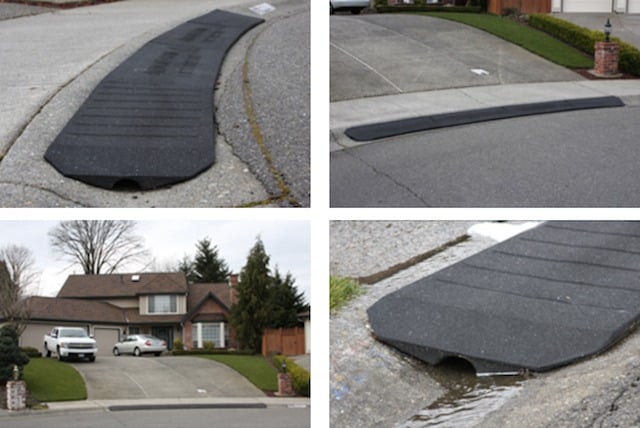Concrete Driveway Curb Ramps – Pros And Cons
Is there a rolled curb below your driveway? If so, you’re probably familiar with bottoming out, slowly backing up, and testing your shocks daily. One solution to this problem is to pour your own concrete ramp: build a simple form, lay down a piece of pipe for water to flow through, and mix up some concrete. Seems easy, right? Here’s what you need to know.
Concrete Driveway Curb Ramp Pros
Pouring your own concrete ramp to fix a rolled curb can be tempting for a couple of reasons:
1. It’s cheap. You can buy a bag of concrete mix, find some scrap for a form, and buy a section of PVC pipe for less than you’d spend on a couple of uncooked steaks. From there, it’s a little bit of time and a just-add-water scenario.
2. It’s (fairly) easy. So long as you have some experience, building your own concrete ramp is straightforward.
But, like anything, there are a lot of downsides to this particular solution.
Concrete Driveway Curb Ramp Cons

A DIY concrete curb ramp is one way to “fix” a pesky curb, but very often this is a bad solution. Image via NewPaloAltoHouse.com.
Pouring your own concrete ramp is problematic. If you do decide to DIY this thing, here are some issues you’ll more than likely run into:
1. Legality. Surprise surprise, laying concrete on your curb isn’t usually legal. A local code enforcement officer may issue a ticket and require you to remove the ramp from the curb. They may also demand that you pay to repair any damage caused during the removal process.
Unfortunately, it doesn’t take long for a cheap DIY concrete curb ramp to become very expensive.
2. Longevity. Because concrete curb ramps are poured on top of previously poured concrete, they don’t form a stone-like bond to the existing concrete. Over time, this causes all sorts of problems. In colder climates, “freeze jacking” (where water penetrates the space between the ramp and the existing curb) will crack the ramp. Unless the edges of the ramp are supported, odds are good the concrete will spall (break off) along the edges. This makes for an unattractive (and potentially hazardous) ramp after as little as 18 months.
3. Letter carriers, UPS, et. al. Finally, DIY concrete ramps make it extremely difficult for anyone who drives along the curb. The US Postal Service letter carrier, the UPS or FedEx driver, city street sweepers, and anyone trying to parallel park can run into your ramp. If the ramp causes any sort of damage – or if it becomes a constant annoyance – odds are good that someone will complain to the city about your concrete ramp. That leads to #1.
While there are certainly some situations where building your own DIY concrete curb ramp can work, it’s important to make sure you understand the rules, permit requirements, and so on.
Concrete Ramp Alternative – A BRIDJIT Curb Ramp

At the end of the day, a DIY concrete curb ramp is a less than ideal solution to jarring rolled curb problems. Instead, consider a BRIDJIT Curb Ramp to smooth out your daily commute from the driveway to the roadway.
BRIDJIT is a great choice:
- They work without causing trouble. The BRIDJIT ramp works great, and it’s unlikely to cause any problems with the neighbors, code enforcement officers, etc. Because BRIDJIT ramps can be removed when the street sweeper comes down your street (NOTE: They’re pretty heavy, so removal isn’t something you do casually), it’s unlikely they’ll be a problem for the city. Because the ramp ends have a gradual edge, the USPS letter carrier won’t mind driving over your ramps every day.
- They’re extremely durable. Because the BRIDJIT ramp set is made from recycled tire rubber, it’s very durable. You can drive a commercial truck over them without worrying about damage, weather doesn’t effect them, etc.
- Easy Install. In the time it would take you to brew a pot of coffee, your driveway could be transformed.
- Water flows freely but won’t cause damage. BRIDJIT curb ramps are designed to let water flow beneath, meaning you’re not breaking any city ordinances by installing one. If water gets under the BRIDJIT ramp and freezes, no problem. Unlike concrete, ice can’t crack or damage BRIDJIT ramps.
Summing Up
While it’s certainly possible to build a great concrete curb ramp, it’s not necessarily advisable. Concrete ramps don’t always hold up to wear and tear, and city ordinances often prohibit them.
BRIDJIT Curb Ramps, on the other hand, make entering and exiting your driveway easy without any problems with install, ordinances, etc. Because they’re made from recycled tires, BRIDJIT ramps are incredibly durable, too. Check them out here.


